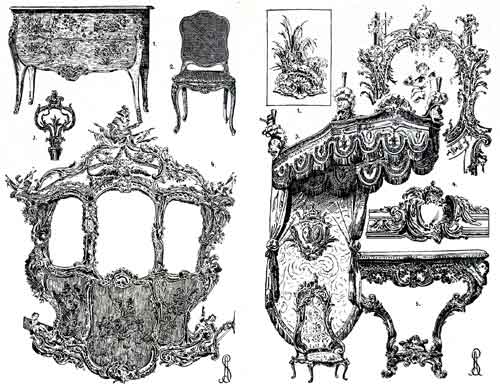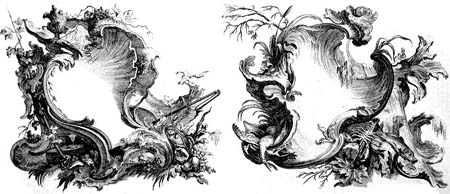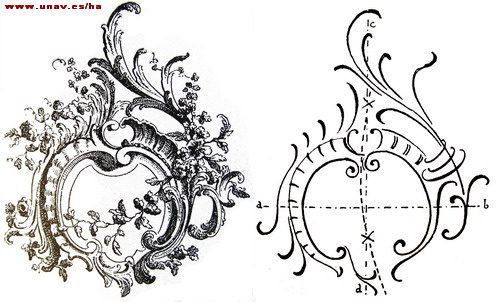4. 4. The Rocaille
The "rocaille" was a French solution to introduce variety in the architectural and ornamental frames. The "rocaille" was developed by the French architects and designers in the first third of the XVIII century, in the interior decoration of the Royal residences.
The rocaille was primarily developed to enrich interior panels, to diminish the heaviness of the architectural elements, and to add touches of grace. Soon the rocaille was present everywhere; and all the things (a fork, a chair, a carriage) had a strong "family resemblance". This "family resemblance" is the "Rococo Style"; and perhaps it is the first "style".

Speltz, A., The Styles of Ornament, pl. 317 and 318.
Shields of Rocaille
The panels were frequently decorated with shields or little frames shaped like curving shields. And the design of shields provide (before and now) the best examples to learn how to use the rocaille. In the Rococo Style, the shield's border has not a definite character (animal, vegetal, mineral).
Really, it is not a border, it is a conglomerate of multiple fragments of shells and foliage. The shells,
palm-branches
ragged acantus leaf.

French Anonime Print, The Seasons, Middle 18th Century
The palm
But the secret of the rocaille is in its contour. It is a melodic contour. The S-shaped and C-shaped curves are the melody. The protuberances and expansions, with "ribs" flash (radiant lines) are the accompaniment.
The XXX its resemble the French "chiffres", the calligraphical monograms o ciphers.
"The essence of the style is that these curves shall never be continous for more than a short distance, nor make more than one double curve like the letter S, without breaking off to begin again abruptly." (Sturgis, Dictionary, term "Rocaille").
"Curves were infinitely varied and cunningly contrasted, curves of contrary flexure being everywhere opposed or combined in a play of coquettish advance and retreat."
(Ward, W. H., Architecture of Renaissance in France, vol. II, p. 361).
A print of Franz Xaver Habermann (German designer, sculptor, 1721-1796) teaches how to make it.

Habermann,Franz Xaver,
Rocaille in panels
For the panel designs, the designers have preferred thin, minute and delicate mouldings; and the tops, bottoms, and corners of all panels was decorated with rocailles.
"Roman cornices and round arches are banished. Panels of walls and doors are enclosed in two or thress separate lines of moldings, the finer ones inside the heavier outer moldings." (Hamlin, A. D. F., A History of Ornament, vol. II, p. 250).
"Mouldings became flatter, slimmer; cornices and pediments casting bold shadows were replaced by gentle coves and graceful volutes. The bottom as well as the top of panels were curved and broken, angles and junctions of all sorts were managed by means of scrolls, flourishes, and other softening devices." (Ward, W. H., Architecture of Renaissance in France, vol. II, p. 360).
Rocaille in furniture
Its was a very effective system. Soon the furniture adopted also individual shields of rocaille; and also the right lines of the furniture were made sinous curves (fig. 1, 2, 3).
The small pieces of furniture and household were transfigured. The compact volumes (e. g. the snuffboxes) adopted the Rococo contour; and the linear objects (e. g. the chandeliers) become a tumultuous mixture of rocailles (fig. 4).
iron work
The rocaille invaded the iron work design, the grilles, gates and balconies. The vertical bars was curved and contorted. The qualities of iron was consonant with the new formal possibilities (fig. 5). The blacksmiths took advantage of it.
"The specials qualities of the material and the structural requirements of its use in grilles, gates and railings, lent themselves to this sort of design, which here, therefore, exhibits a propiety too often lacking in the furniture and architecture." (Hamlin, A. D. F., A History of Ornament, vol. II, p. 257).
life and decease of a Style
The best rocaille's designs are master works. But it is easy to compose an appropriate rocaille. Anyone can do it; almost all the rocailles "work" well (it is a too effective system).
The fashion was dramatically widespread in the Continental Europe through multiple sets of ornamental prints.
In France, Lajoue (Lajoue, Jacques de, II: French painter, 1687-1761)
In the middle of the XVIII century it was a ubiquitous ornament
In Germany, designers,
In Spain, the rocaille became extremely popular. Since about 1730 all the retables (sp. Retablos), altarpiece made of fixed panels, adopted the Rococo Style.
English designers approach this fashion with less enthusiasm (a too complicated and too French fashion).
The rocaille was sentenced to death for its effectiveness. About it become too vulgar and boring.
Then the rocaille was expelled from the palaces where it was born.






















